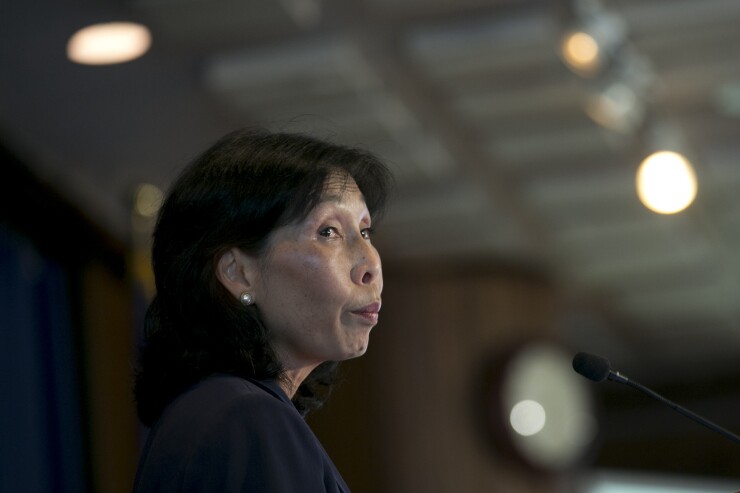WASHINGTON — At a time when the Trump administration is mostly appointing regulators eager to roll back post-crisis regulations, the nomination of Nellie Liang to a seat on the Federal Reserve Board is something of a throwback.
Most observers viewed the pick as a departure from the norm. A Democrat, Liang helped develop the Fed's post-crisis regulatory apparatus as director of its Office of Financial Stability before leaving to become a fellow at the Brookings Institution, the left-of-center think tank.
Rather than resent the post-crisis framework, Liang helped build that framework. She warned in a speech last year that some recent proposals "to scale back capital requirements and stress tests would risk long-run macroeconomic stability."

“As most of the actors from the financial crisis have exited the stage, Ms. Liang’s deep background will be a tremendous resource for the Fed to draw upon,” said Cornelius Hurley, a professor of the practice of banking law at Boston University.
But others saw her as more of a consensus pick, reflecting a mindset of both past and current Fed leaders who approve of how the central bank has monitored the biggest financial firms since the crisis but also see room for improvement.
Oliver Ireland, a senior counsel at Morrison & Foerster and former associate general counsel at the Fed, noted Liang’s institutional knowledge of how the Fed works, and what it can and cannot do. While she played a key role in implementing the post-crisis reforms, Ireland said she may be willing to tailor certain regulations.
“Could there have been more appointments who would more likely rollback regulatory requirements on large banks, sure,” said Ireland. “You listen to some of the Democrats on the Hill that don’t want anything to change, I don’t think that’s her by a long shot.”
The administration's previous regulatory nominees have tended to elicit partisan reactions, with Republicans overwhelmingly approving regulatory relief advocates and Democrats being more prone to oppose regulators they see as advocating for the industry.
But experts say Liang could find supporters and critics in both parties.
Brandon Barford, a partner at Beacon Policy Advisors, said that there is a “potential for pushback from both sides” during her confirmation hearing.
“Republicans could ask some very pointed questions related to what they may think of as overregulation," he said. "I think [Democrats will] ask tough questions about her previous roles at the Fed, and potentially, in their minds, lapses in supervision of various big banks by the Fed.”
In her speech at the International Finance and Banking Society at Oxford University in July 2017, Liang warned against changing standing bank capital requirements, arguing that they yield net benefits and that there is “little to no evidence that credit availability is constrained.”
She also suggested in that speech that the Fed should consider raising the countercyclical capital buffer while the economy is doing well — a position that could put her at odds with regulators elsewhere in the pro-growth Trump administration. She did note, however, that "some current proposals to reduce regulatory burden have merit."
With Liang's nomination, the administration has now named its three choices to fill out the seven-member Fed board. However, the nomination of Michelle Bowman has
A 30-year veteran of the Fed's staff before moving to Brookings, Liang was involved in developing the Comprehensive Capital Analysis and Review, the central bank's system of stress tests for the biggest banks.
“She helped create the regulatory framework for the biggest banks,” wrote Jaret Seiberg, an analyst at Cowen Washington Research Group, in a research note. “As a result, we believe she will be largely supportive of keeping that framework in place.”
She may get substantial support from Senate Democrats, unlike a number of other Trump nominees. But Senate Republicans may be more skeptical. Her views appear to be vastly different from those of President Trump, who has called for the Fed to relax its restrictions on banks and has
"Liang is a diverse pick and a surprising departure from what we've come to expect from Trump administration nominations,” said Jordan Haedtler, campaign manager for the Fed Up campaign.
She would also be the first Asian-American to serve on the Fed board, as well as the 10th female.
The pick comes at a time when “the Fed has been under fire for a lack of diversity at the top,” said Justin Schardin, a fellow at the Bipartisan Policy Center.
If confirmed, Liang is also expected to be an ally of Powell on monetary policy, and appears to support Fed Vice Chairman for Supervision Randal Quarles’ efforts on amending the post-crisis regulatory framework but maintaining the basic structure, according to Brian Gardner, the director of research at Keefe, Bruyette & Woods.
But, Gardner wrote in a client note, Liang likely “will be a solid vote to keep most of Dodd-Frank in place if the Senate confirms her.”
Liang’s extensive understanding of monetary policy would also lend itself in her work with other members of the board, including Vice Chairman Richard Clarida and Fed Gov. Lael Brainard, said Karen Shaw Petrou, managing partner at Federal Financial Analytics.
“I think she will be a very strong and analytical voice both in the significant regulatory decisions, the significant regulatory agenda that Vice Chairman Quarles has laid out and in the broad debate over redefining the federal reserve monetary policy in the lower-for-longer policy" on interest rates, said Petrou.
Powell has routinely called on the Senate to confirm the president’s nominations precisely because there are too few members to adequately handle the workload.
Haedtler said the fact that Liang is close with Powell suggests he may have played a role in picking his team of Fed governors.
“There’s been a marked difference between the more mainstream selections (Clarida, Bowman, Liang) that came after Powell was named Chair, and the two nominees who came out before (Marvin Goodfriend and Randal Quarles),” Haedtler said in an email.
John Heltman contributed to this article.





